Introduction
Each piece of art contributes greatly to the understanding of human intentions and meanings that stand behind a picture or a symphony. Different authors have different background and different experience in life matters that can be interpreted with the help of objects of art. Mood and theme make pieces from different disciplines look and sound in a similar or the same way though it is up to the audience to decide on the similarities and differences of a painting, a poem, and a film.

Pieces of Art for Analysis
Literature
- Work of literature: “Power” – poem written by Adrienne Rich in 1974.
- This piece of art represents the discipline of literature created by a female American writer.
- Feminism can be called one of the prominent topics of her works as she was a feminist.
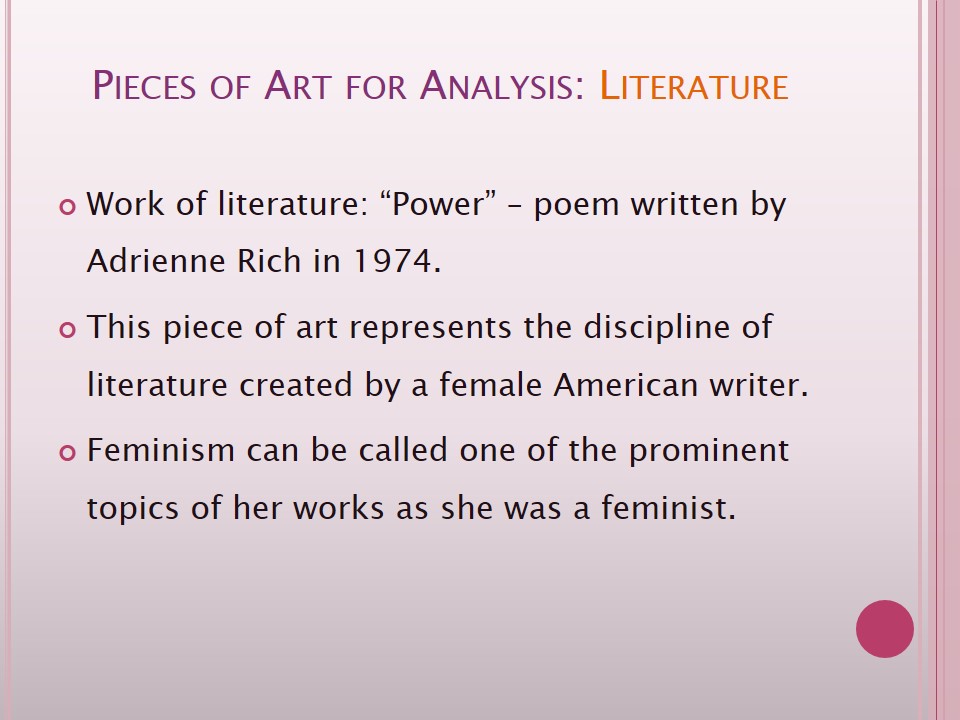
Painting
- Piece of painting for analysis is The Marsh in a Forest created in 1665.
- The author is Jacob van Ruisdael, a Dutch painter of seventeenth century famous for his landscapes and portraits.
- The painting is currently displayed in the Gallery of The Hermitage in St. Petersburg, Russia.
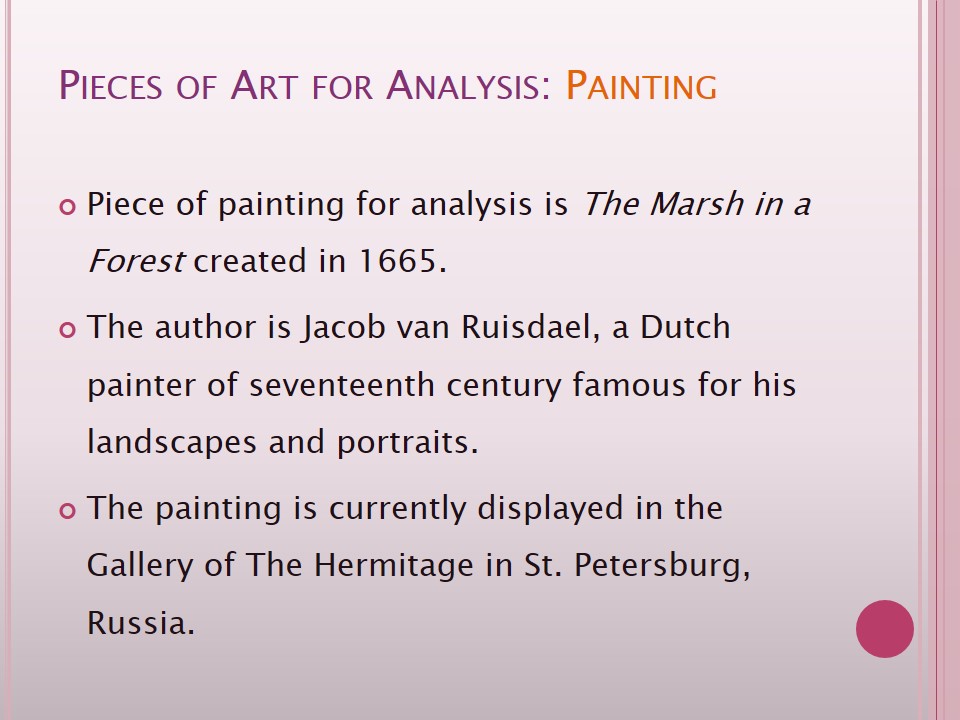
Movie
- Work of cinematography for analysis is the movie Pay It Forward filmed in 2000.
- The director of the movie is Mimi Leder; the movie is based on the novel Pay It Forward by Catherine Ryan Hyde.
- The movie is starring Kevin Spacey, Haley Joel Osment, and Helen Hunt.
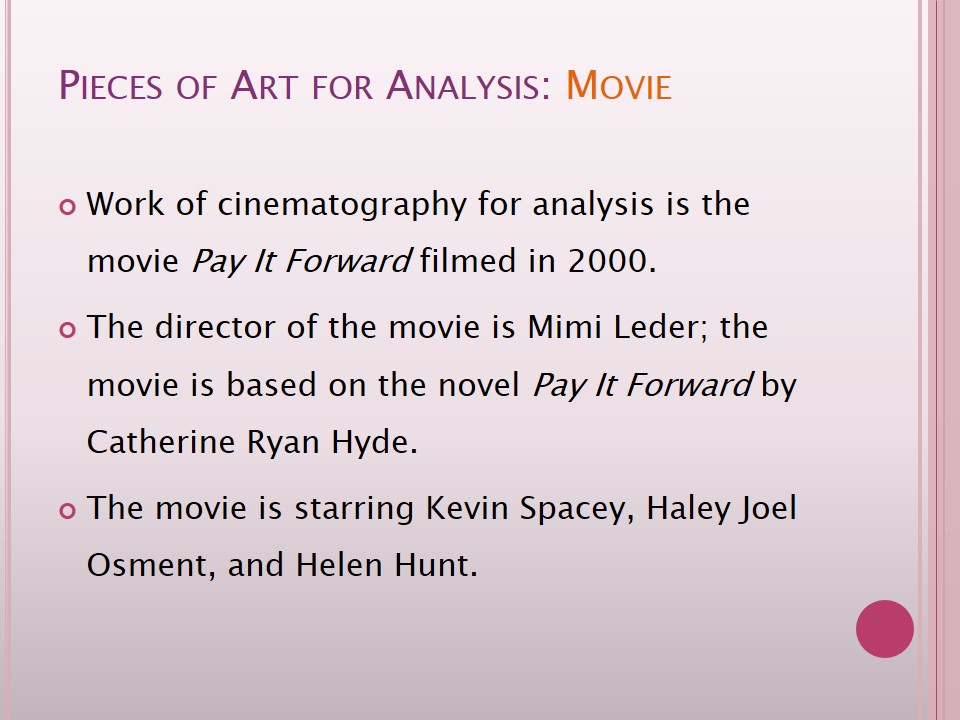
Themes and Mood Common For All Pieces
The poem describes the power of a woman and her use of that power. Actually her main power is the knowledge obtained meaning that she knew what she was doing and that she could die; she got an element but had to give her life for that knowledge and fame.
The painting is full of contrasts such as a young tree and an old dead tree, earthy colors of the ground and marsh and azure of the sky. It suggests the idea of replacement and that each concept has its beginning and should make room for something new when it is old.
The movie is based on the concept of exchange while one has to do something good when he/she is treated nice by others.
Thesis statement: Each concept has its value in this world; these three pieces of art have a similar mood and a theme of exchange when something is given in exchange. It is important for a teacher to know this rule and know how to explain it to students. For instance, these pieces of art can be used to evoke their thoughts concerning the world and its values.
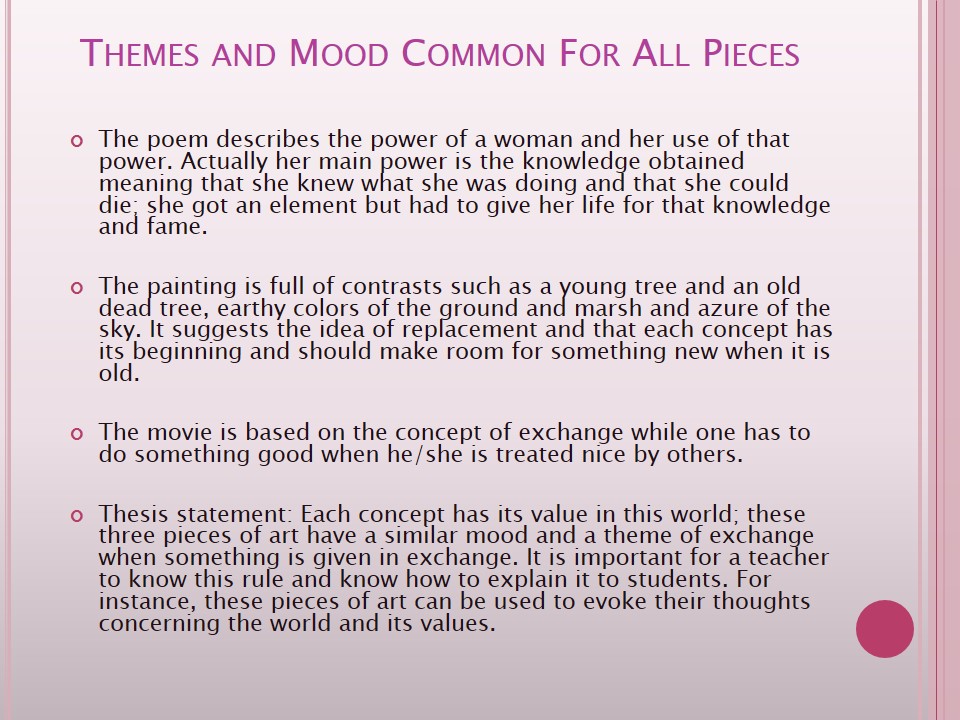
Objective Analysis
Literature
“Power” (1974) by Adrienne Rich is a blank verse created in the form of thinking aloud.
The main subject matter of the poem is the power of Marie Curie, a famous chemist and physicist, who managed to discover radium and polonium and gave her life for this knowledge. Her power to operate in the fields closed for women was based on her moral strength so, “She died a famous woman denying her wounds” (Rich, 1993, p. 73).
The author conveys the message with the help of different approaches such as the following ones:
- a blank verse;
- anadiplosis (repetition of “denying her wounds” (Rich, 1993, p. 73)) in the last stanza;
- comparison of a discovery with the backhoe that opened up something new on earth;
- introducing a story of the author’s personal experience of reading about the main character.
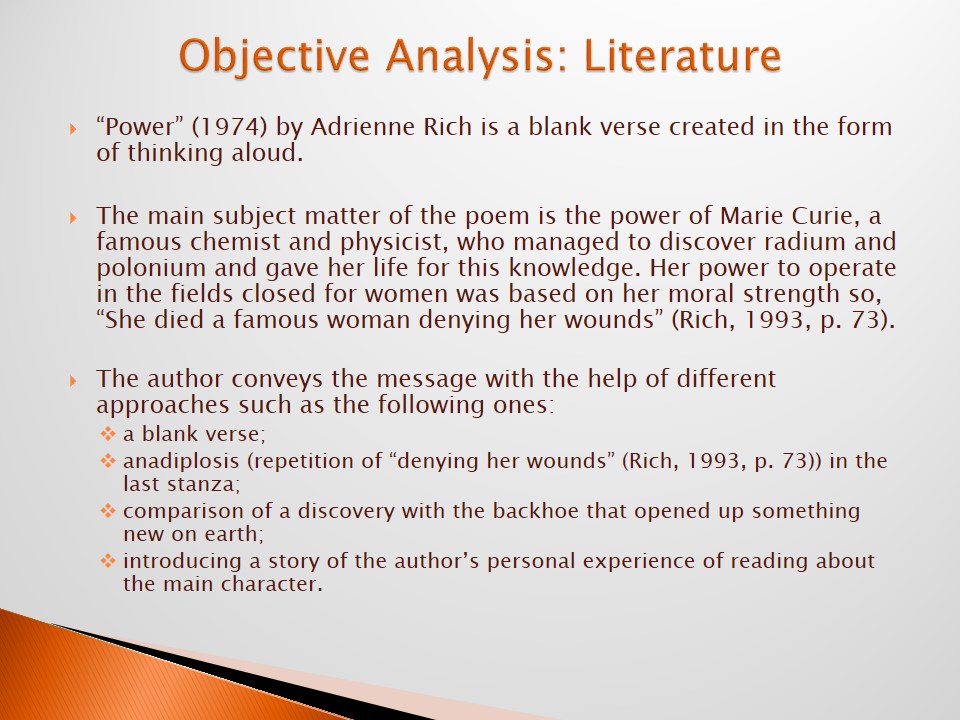
Painting
Jacob van Ruisdael’s The Marsh in a Forest (1665) created in the traditions of the subtle dubs and artificial landscapes.
This two-dimensional visual art is a painting made in Baroque style typical of the European art of late sixteen- early eighteen centuries with the help of oil.
The landscape is created with the help of subtle techniques of Dutch landscape painting and detailed depiction of the smallest components of the composition.
The painting suggests the idea of the power of nature and the number of contrasts that exist in the world while each idea is a substitution for another one. All details contribute to the overall magnificence of nature contrasted to the insignificant role of people created with the help of a small figure of a hunter in the background of the picture.
The manner of presentation and integrity of images and tones help to differentiate this piece of art from others in this discipline.
Nationalism is one of the peculiar features of van Ruisdael’s paintings, the composition is very coherent while the tones are different contrasted to other painters of the epoch who used a unifying tone for the entire composition. The symmetry of the picture suggests a more dense ordering on the right and a less dense ordering on the left combined with lighter tones used by other painters of the era.
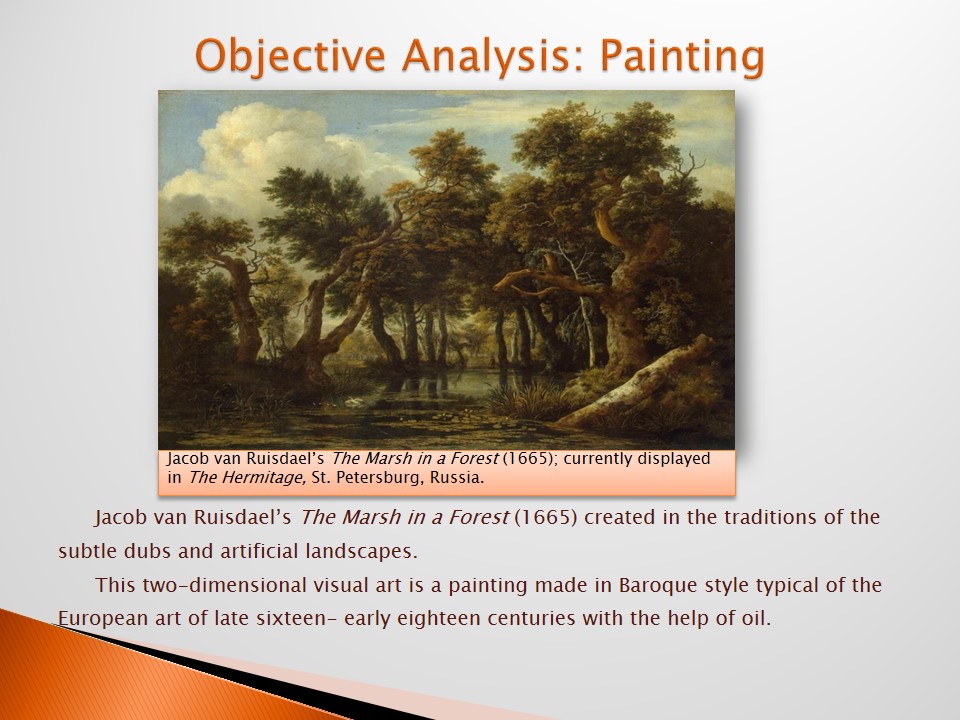
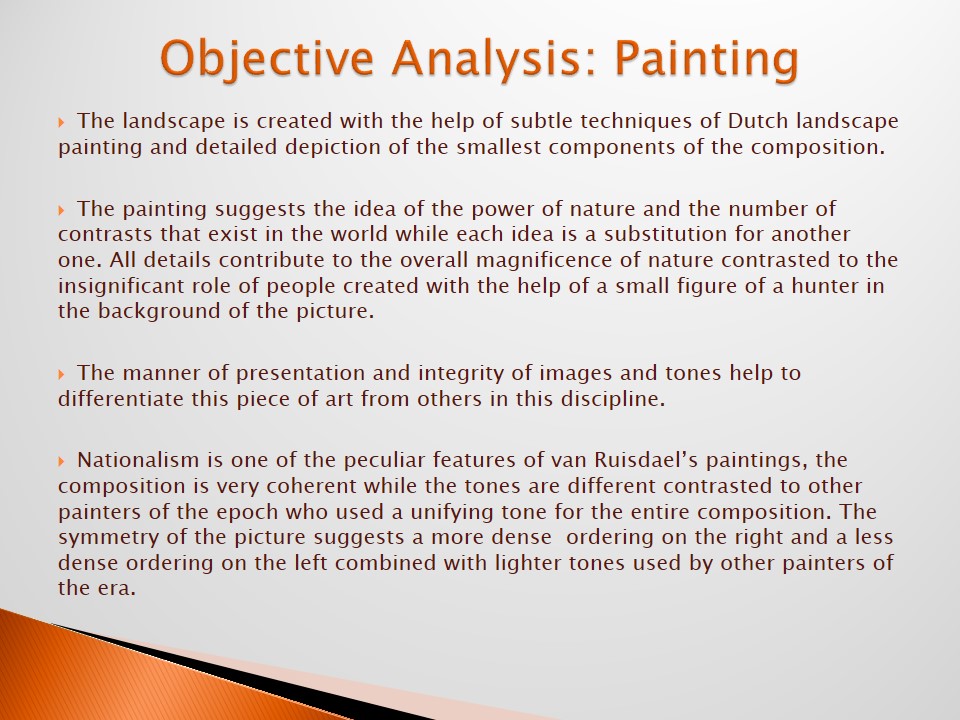
Movie
The movie Pay It Forward is a combination of drama and romance starring Kevin Spacey, Haley Joel Osment, and Helen Hunt.
This movie focuses on the story of changes and the assignment given to students, who are eleven, to change the world. In other words, a little boy suggests a concept in accordance to which each person has to make a good deed in relation to three other people while each of those has to make the same. This theory is aimed at improving the world.
This movie is very emotional; actors play professionally while the setting is rather realistic for the audience to believe the story and its possibility.
The design of the movie suggests a popular culture approach where the things and setting are depicted very naturally. The form of the movie includes the key storyline of a boy’s theory and its implementation and a journalist who eventually learn about this concept and attempts to find the origin of this cultural-philosophical movement that has spread all over the country. Supportive lines include a journalist who intrudes into the lives of ordinary people and a boys mother and a teacher who become closer.

Subjective Analysis
Literature
The poem “Power” by Adrienne Rich can be understood as the symbolic depiction of the victim given to receive something which was of primary importance for a person. Thus, Marie Curie wanted to purify a chemical element; so, she did that but her organism was ruined by radioactive nature of those elements.
The beginning of the poem presents an allegory of a backhoe that is used to discover certain elements in the earth while Curie is described as a woman who managed to discover something by paying a very high price of her own life.
The mood of the poem is depressing in the beginning and the middle while it is really encouraging and inspirational in the end.
The poem covers themes of knowledge and cost of the truth, women in the scientific fields, and ability of a woman to overcome certain difficulties courageously in spite of natural phenomena.
I reached such conclusions after reading this poem and thinking about the role of women in the society in different epochs and comparing the modern situation with the one described in the poem.
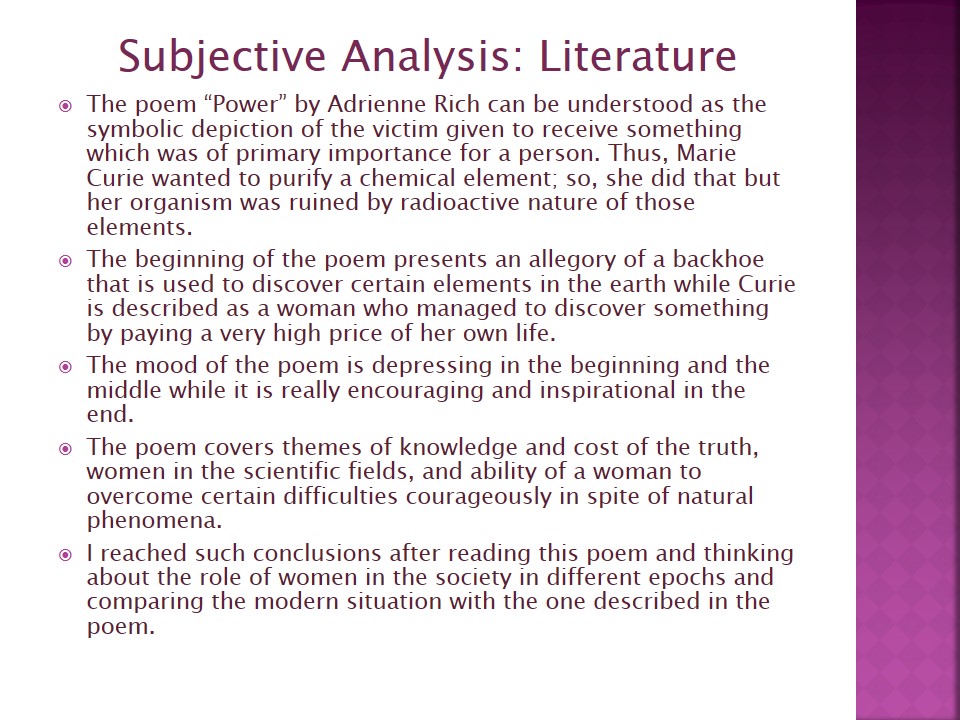
Painting
The painting The Marsh in a Forest by Jacob van Ruisdael can be understood as the attempts to depict the power of nature with the help of calm landscape with nice weather as the character of the picture.
The mood of the painting is very calm because graceful trees visually composed in a rather symmetrical manner create a nice structure and color organization of the picture.
The themes that can be traced in the painting include the power of nature contrasted to the role of a human being in the huge world, changes that take place in nature such as young trees growing as a substitution of old dead trees that should be replaced.
I reached such conclusions after looking at this picture, learning the smallest details of it, and inferring from what I have seen.
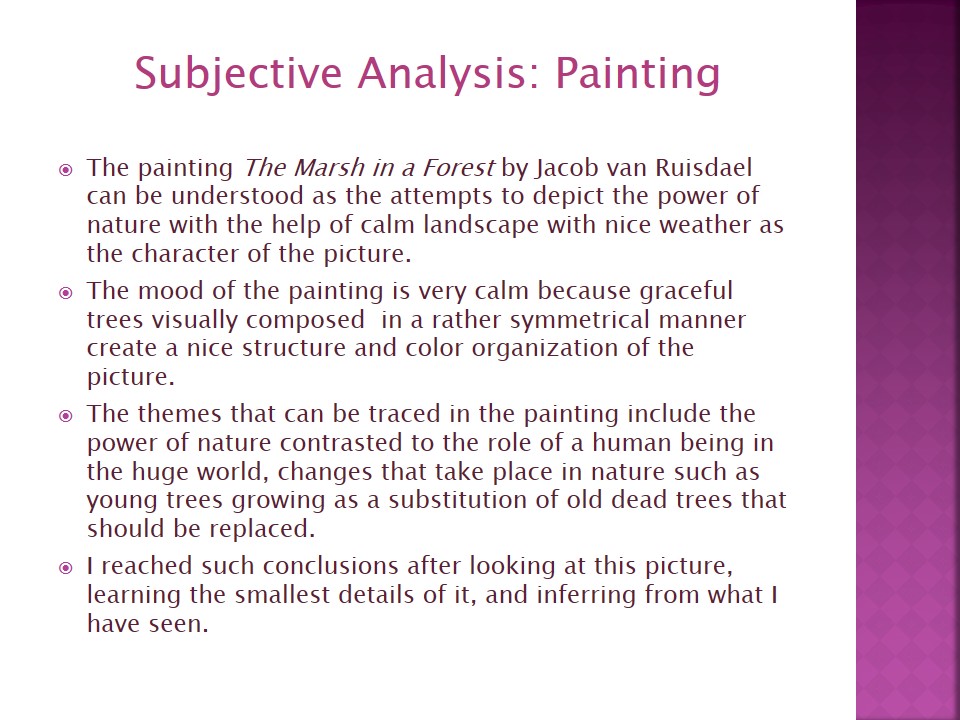
Movie
Pay It Forward (2000) is the movie about the education of children and responsibility they take while applying the theoretical knowledge into practice.
The mood of the movie is dramatic and inspirational at the same time. The main character is a little boy who suggests a theory and tries to bring it into life by means of a coordinated plan.
The themes developed in the movie include the relationships between representatives of different generations within and outside the family, education and its effectiveness, rules existent in the modern world, and attempts of people to change the world with or without some help from outside as well as the power of a single person that can inspire others.
I reached such conclusions after watching the movie; however, it took me a bit more time to watch this movie because I did not want to miss important details.
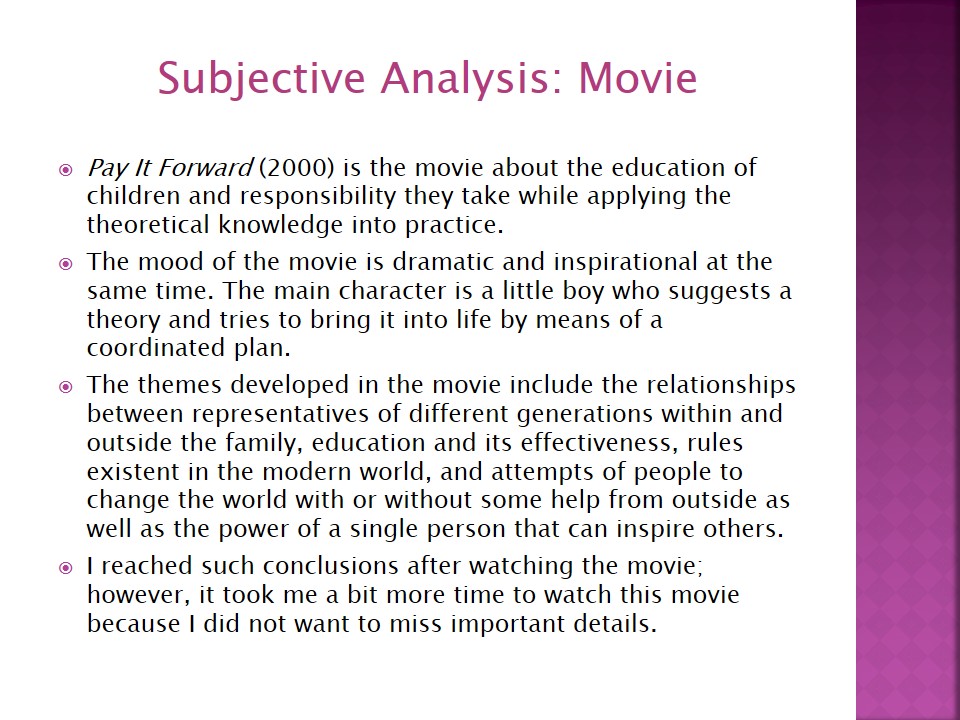
Subjective Analysis: Conclusion
The mood and themes of three pieces of art seems to be similar and very appealing.
The themes developed in the poem, painting, and movie include the power and changes. Perhaps, some people are encouraged with these pieces of art due to their inspiring mood. The wisdom of generations can be found in these objects of art.
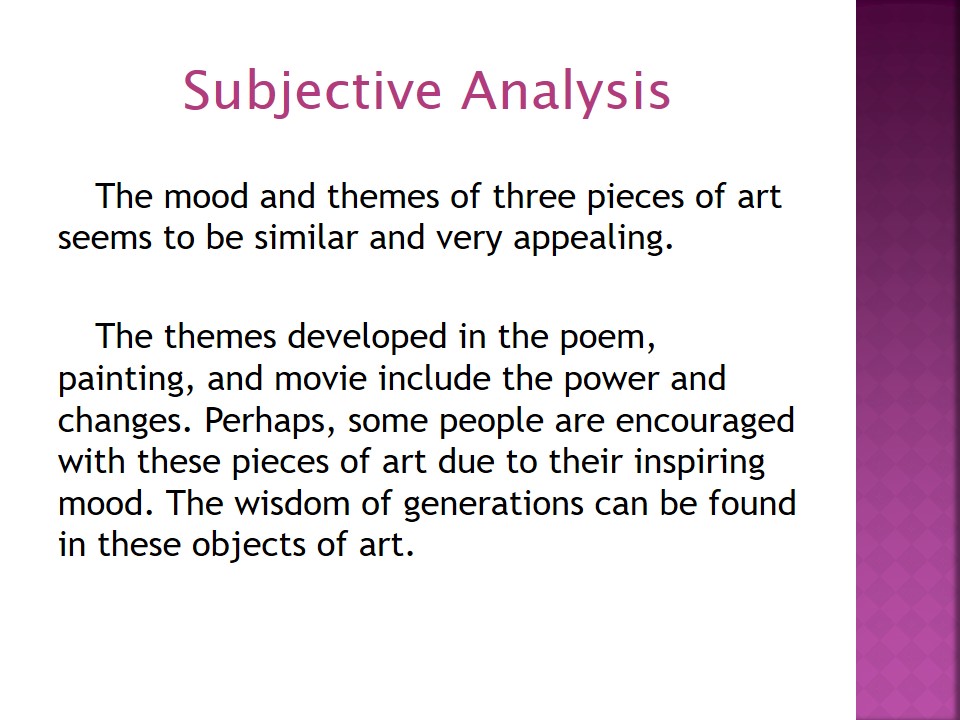
Relationship between Pieces of Art
It is clear that each piece of art has its unique mood, subject matter, and themes developed in a specific way that depends on the author’s techniques and manner of applying the imaginative ideas into practice.
The poem, painting, and movie are analyzed because they have different components that are used to convey the message of the author to the audience.
Similarities
The main similarity in the poem, painting, and the movie includes a combination of themes and mood due to the use of themes to sustain the mood in the way the author wants it to be perceived by the audience.
The main similarities that can be found in the poem “Power” by Adrienne Rich, the painting The Marsh in a Forest by Jacob van Ruisdael, and the movie Pay It Forward (2000) directed by Mimi Leder are the themes covered in each piece of art.
The themes of nature and the way things are changed in the world can be considered the core concepts that contributed greatly to the overall mood of these objects of art:
- The power of nature and the world in relation to the figures of human beings;
- The changes that take place in life;
- The relation of individuals to changes and sacrifice offered to learn something new, to change the world, or to continue the natural cycle of things.
Differences
- The main difference of these pieces of art is the disciplines they are referred to.
- The poem is aimed more at the role of women in society and the sacrifice of Marie Curie while discovering the new chemical element.
- The painting dwells on at glorification of the nature and natural phenomena
- The movie focuses on the relation in the family and between representatives of different generations as well as on the ways for improving the world.

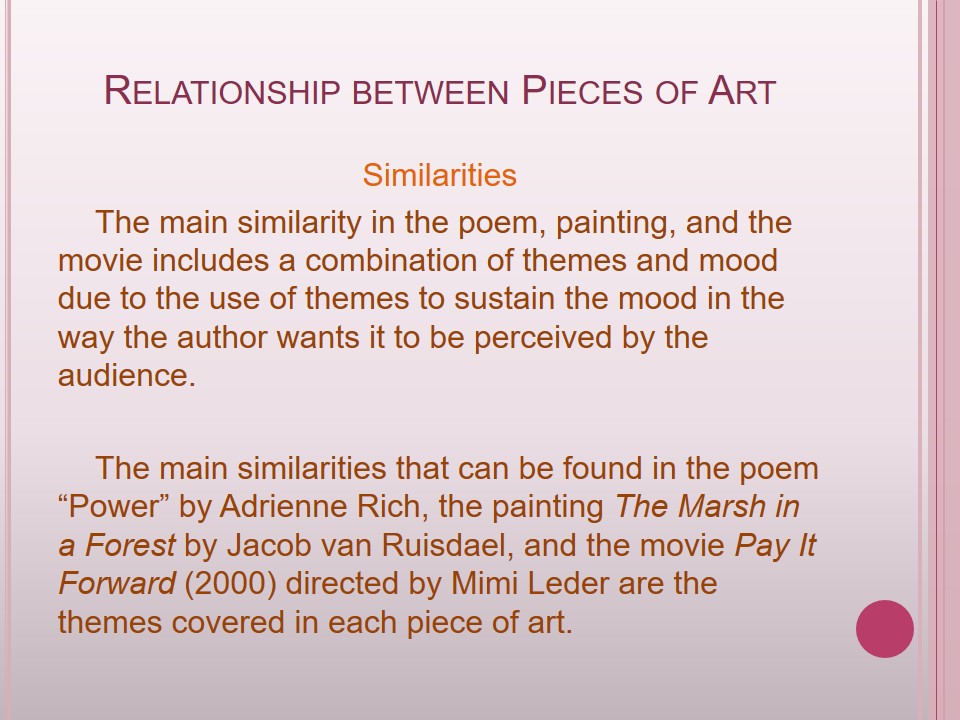

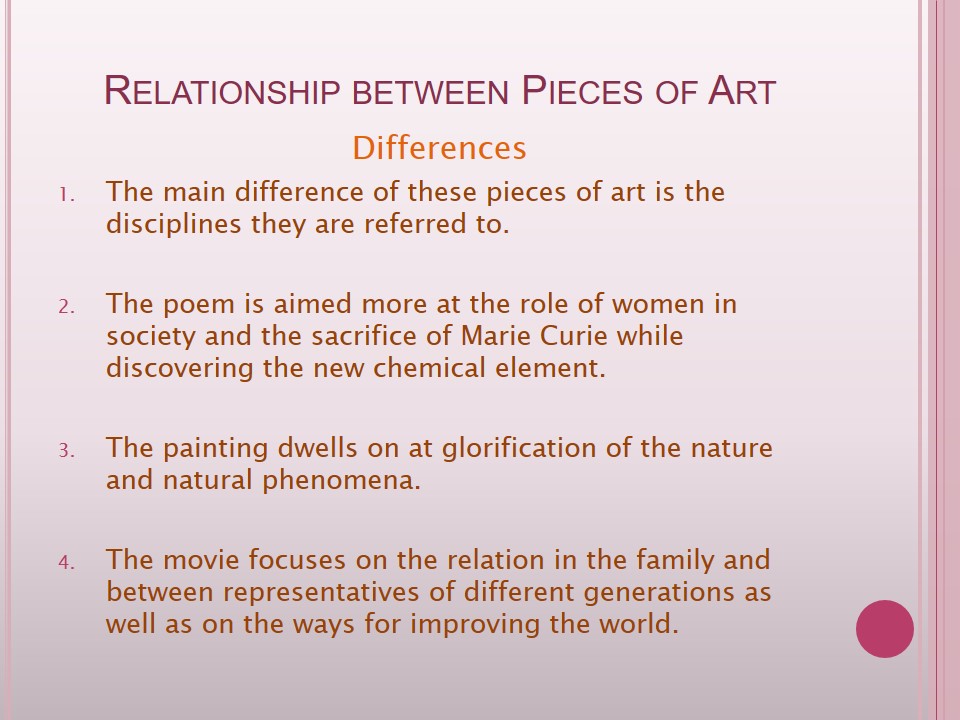
Human Condition
The themes and mood identified in the pieces of art shed light on the human condition with the help of techniques applied by the authors.
For instance, the poem evokes thoughts about the role of a woman in society whereas the painting makes the audience think about the magnificence of the nature and natural laws applicable to the human society; the movie describes the nature of people through their relations with each other and emotional coloring given to every scene due to actors’ professional play.
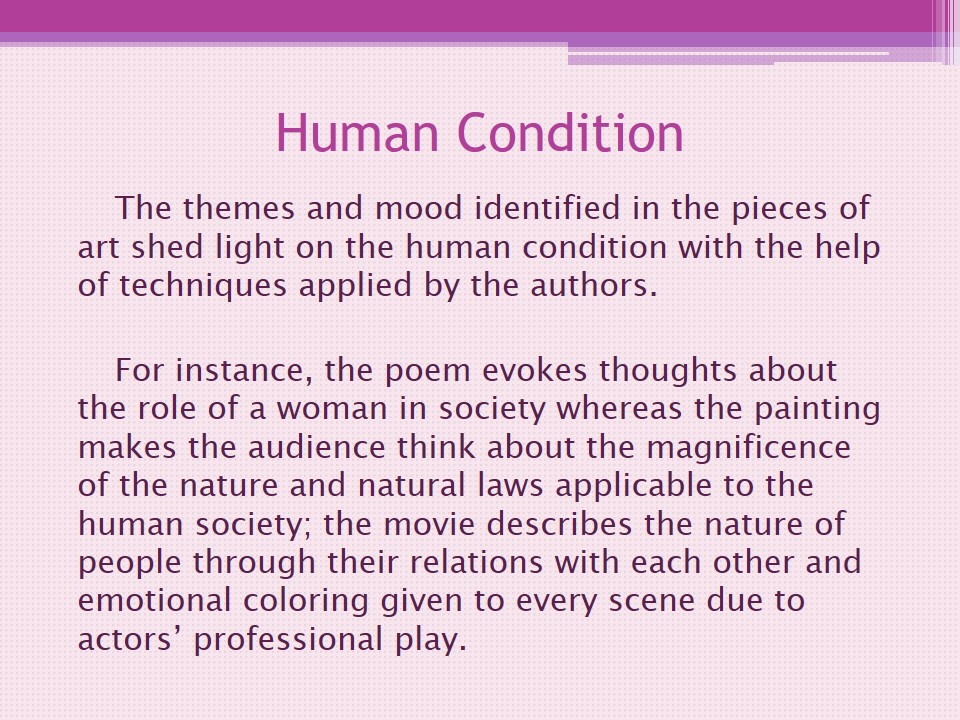
Profession of a Teacher
The profession of a teacher requires knowledge in different disciplines and different sectors of human activity.
In this respect, certain information enables a teacher to answer students’ questions correspondingly with regard to the objective and subjective meaning applied to different objects of art so that each student can associate a piece f art with unique peculiarities.
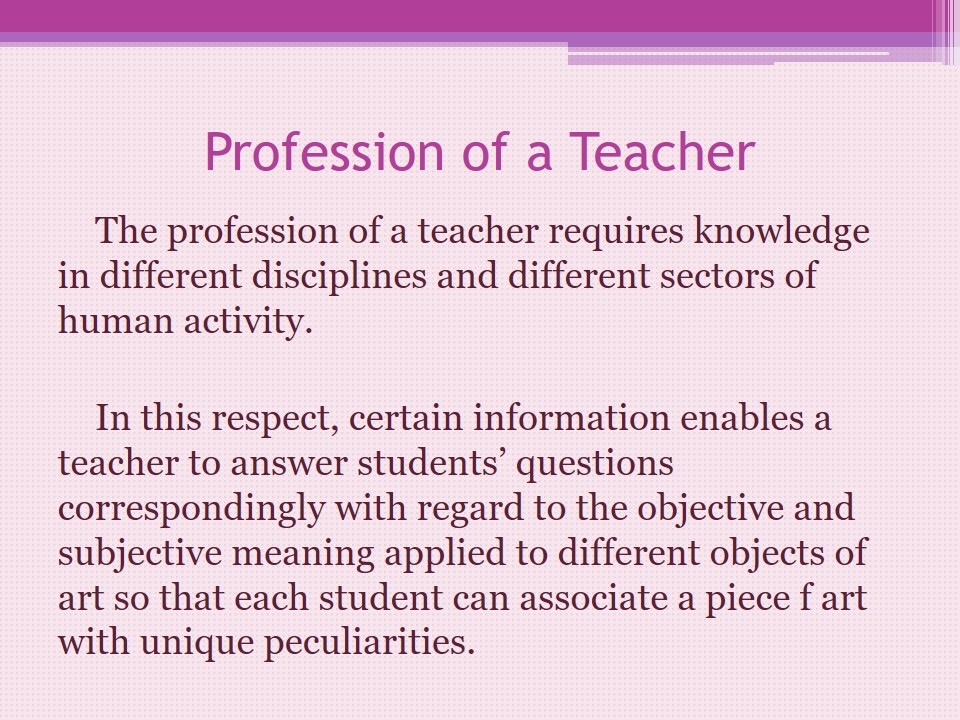
Knowledge of the Humanities
- A teacher who is knowledgeable in the humanities can use certain pieces of art to explain specific concepts to students.
- The themes, moods, and meanings identified in the pieces of art analyzed earlier are closely related to the profession of a teacher due to inspiration that students can get from a teacher and changes that take place as far as a person becomes more knowledgeable in a specific field.

Relationship between the Humanities and Teaching
Knowledge of the humanities is valuable in relation to the profession of a teacher in the following way:
- A teacher can explain certain meanings with the help of allusions to works of literature, paintings, and movies;
- A teacher can understand the relation between certain pieces of art in a different way that a student though should admit possibility of other opinions than his/her to be appropriate and applicable to the situation.
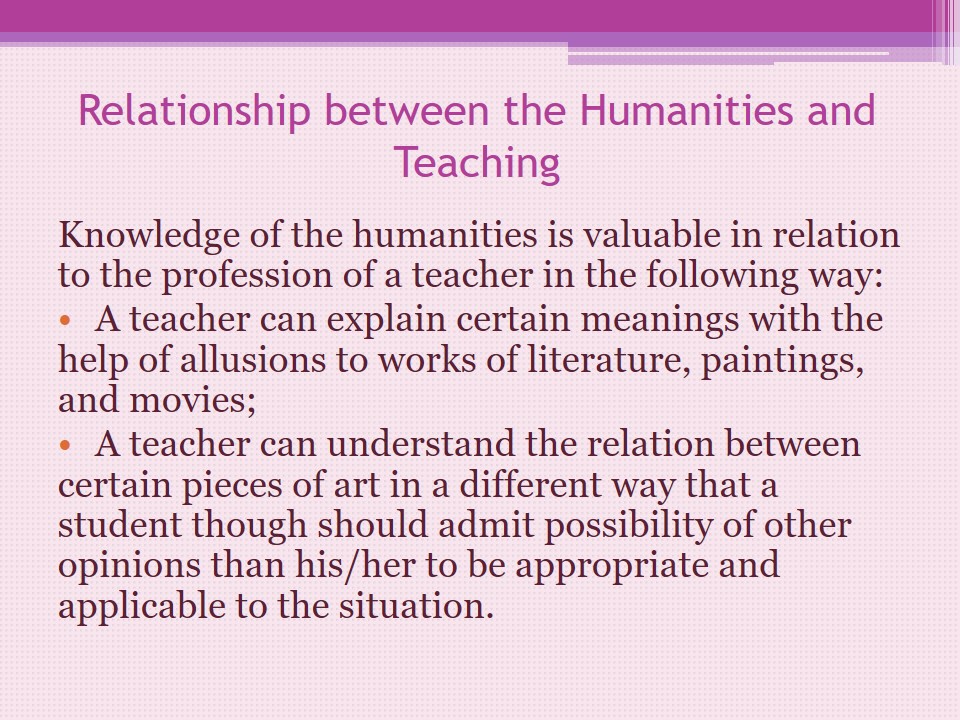
Conclusion
The pieces of art contribute greatly to the understanding of the variety of meanings applied to different concepts. Ideas presented with the help of pieces of art can be perceived in different ways by people. In this respect, it is necessary to suggest a few pieces of art with similar themes to the audience so that they can identify the one referred to by you. The poem can be used in the field of teaching to help students find more meanings and hidden details of the author’s biography as well as reasons for searching for more.
The similarities identified for these three pieces of art help to see how the power of nature and human confidence in personal power can help to make changes to improve the world around. The painting and movie are different and similar at the same time. The similarities found in these pieces of art help to understand the author’s position toward the characters of the movie and objects depicted in the picture. The differences of these pieces of art make them unique and recognizable in their discipline and their mood and themes applicable to different areas of human activity.
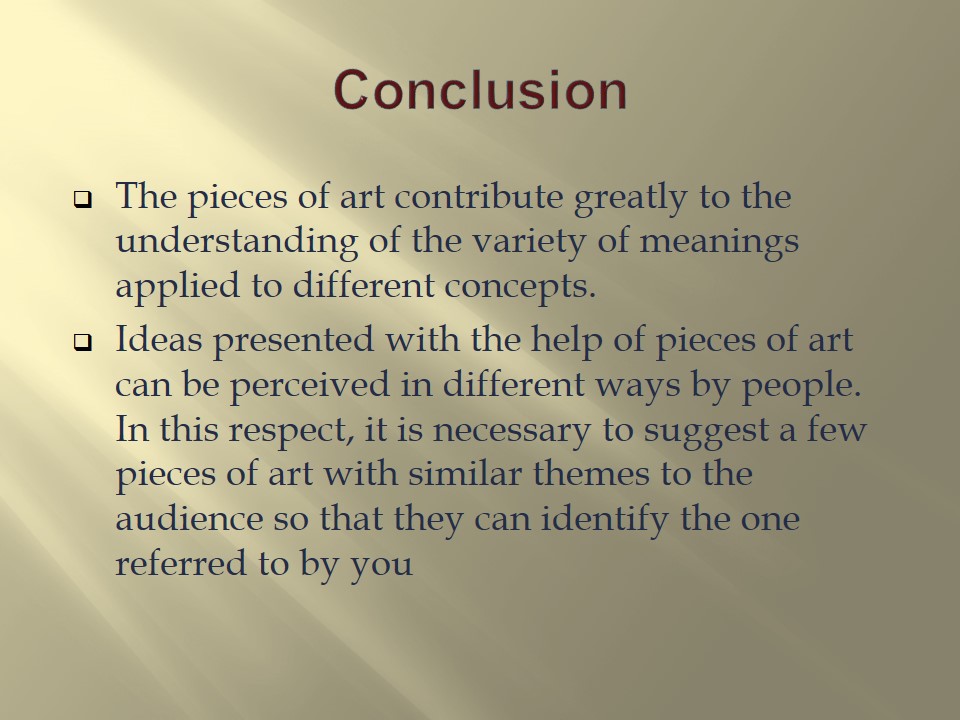
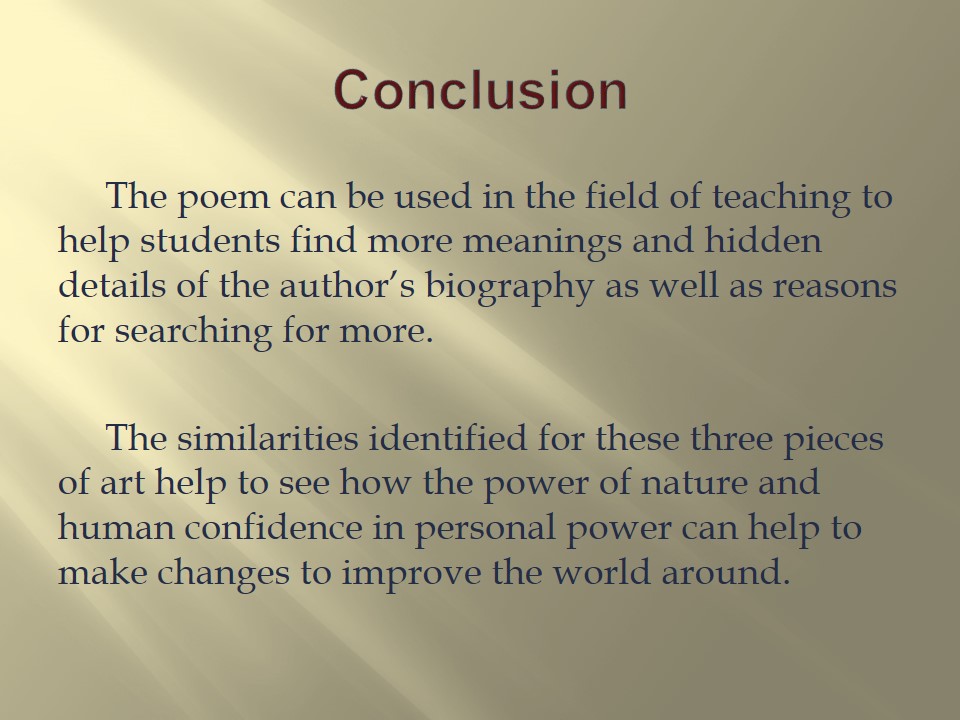
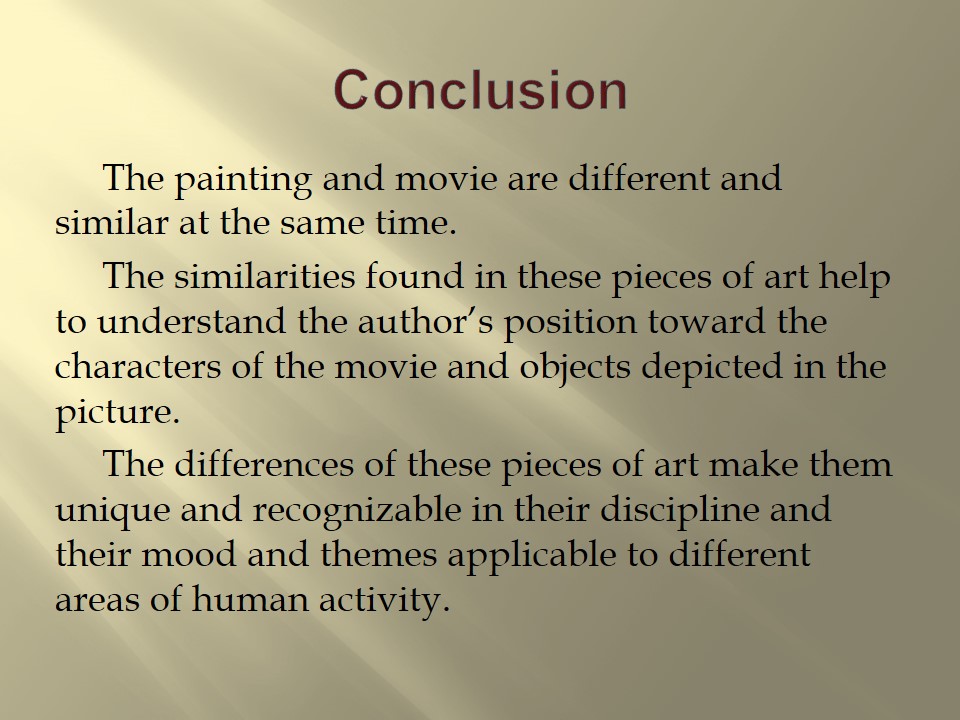
Reference List
McLaglen, M. et al. (Producers), & Leder, M. (Director). Pay it forward [Motion picture]. United States: Warner Bros.
Rich, A. (1993). “Power”. In A. Gelpi & B. C. Gelpi (Eds.), Adrienne Rich’s Poetry and Prose (Norton Critical Editions) (2nd ed.). New York: W. W. Norton & Company.
Ruisdael, Jacob van. The Marsh in a Forest. 1665. The Hermitage, St. Petersburg, Russia.